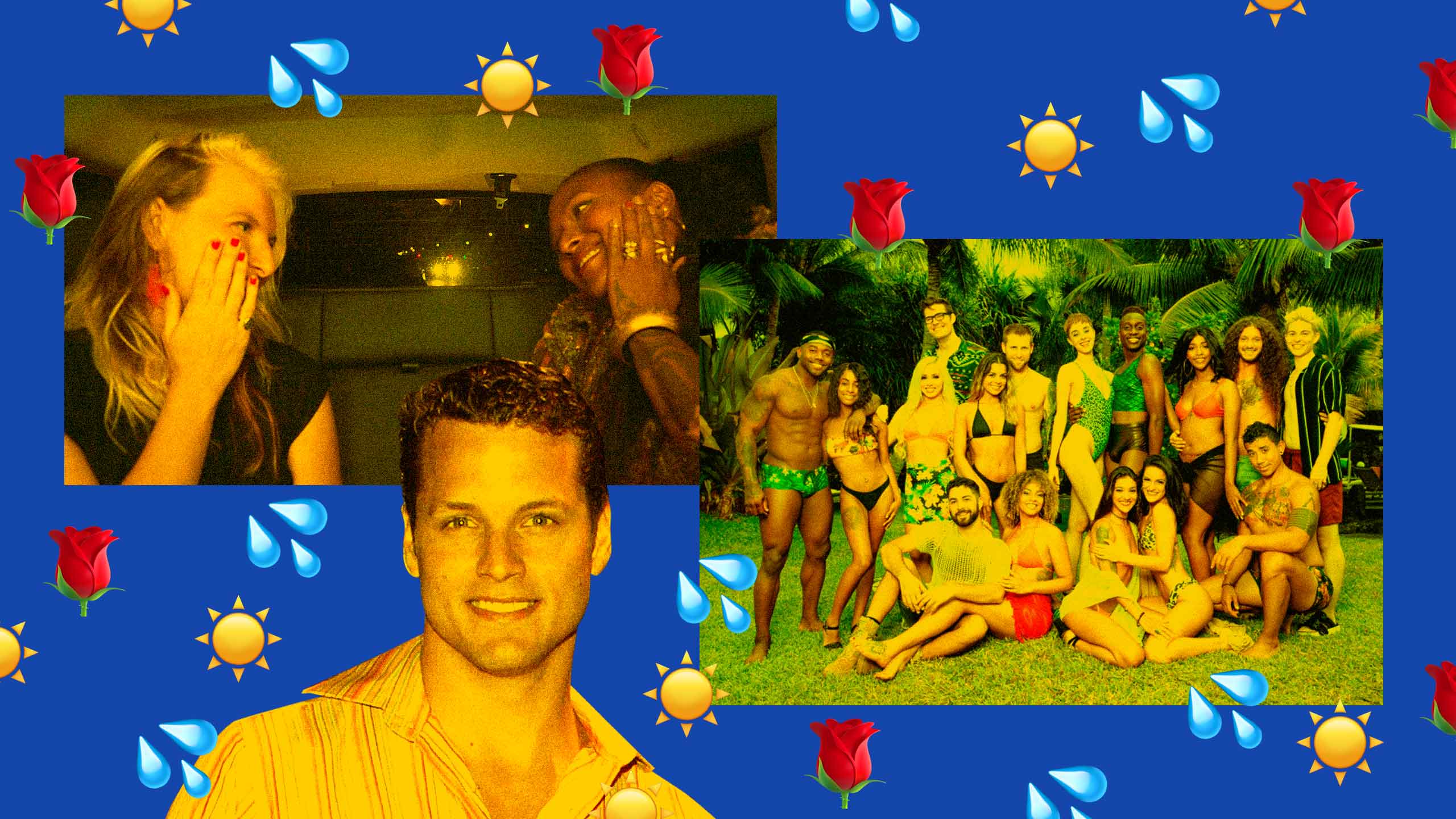The Bachelorette is finally bi.
Last month, the Australian edition of the quintessential dating show announced that, finally ( finally, FINALLY), there is going to be a queer lead. And no, Colton Underwood does not count.
Openly-bisexual Bachelorette Brooke Blurton will entertain both male and female suitors during her upcoming season, marking the first time the aggressively heterosexual franchise has featured a queer lead.
But the bi Bachelorette is far from the first queer dating experience to make its way to reality TV waves. For decades, queer love has been depicted on reality TV with varying degrees of success. What we can all agree on, however, is that when reality TV does go queer, it gets messy—and maybe that’s what we all need right now. Dating is top of mind for many queer folks this summer as we fill ourselves with vaccines (and maybe you’re looking to fill yourself with something else 😉).
In that spirit, here are three queer dating shows worth revisiting to get you in the mood for this hot vax summer and whatever it may bring.
Are You the One? (2014-present)
Where do I even start with the monumental piece of history that is the 2018 season of Are You the One? The fivesome? The virtual reunion before COVID-19 made everything virtual? Everything Jenna did? Much has been written about the messiest season of reality TV known to humankind—one that was rightfully described as a “win for reality TV and horniness.”
The premise is the same as the previous seven straight seasons: a group of strangers are secretly paired off into “perfect matches” based on some method that is ostensibly grounded in compatibility. The goal for the group, in order to split a cash prize at the end, is to figure out everyone’s “perfect match.”

Credit: MTV
When the show is made up of eight straight men and eight straight women, that seems simple. There are only so many combinations. But what if everyone is bisexual? The combinations are endless. Apparently, so is the drama.
Are You The One? broke ground in featuring arguably the most diverse reality TV cast in history, including trans and non-binary contestants. Name another show where a contestant helps another administer their testosterone shot, or where someone speaks openly about dating as a non-binary person. It also broke ground in featuring a fivesome in the aptly named “Boom Boom room,” plenty of breakups and an underwater themed “queer prom.”
Let’s be real: everyone is hot as hell, and watching them parade around a beach house, go on group dates and bicker in classic reality TV fashion is everything you could ever want. (The frank discussions of gender and sexuality are a bonus.) Come to watch Kai and Jenna build a disaster week after week, and stay for the honestly heartful bonding between Basit and Jonathan. It’s the gold standard for chaotic queer reality TV, and we need another season now!
Canadians can watch for free on CTV, and it’s on Amazon Prime for you American folks.
Boy Meets Boy (2003)
Are You The One?’s queer season will forever encapsulate 2018. Boy Meets Boy, for better and for worse, will encapsulate 2003.
Queer dating shows of the early and mid-aughts had a strange obsession with secrecy and the threat of the “hidden straight,” with pools of both heterosexual and gay contestants. Playing It Straight, which had U.S., Australia and U.K. iterations that aired between 2004 and 2012, took this obsession to an extreme, with a straight woman attempting to discern which of her suitors were straight and datable, and which were homosexuals lurking in the wings.
Boy Meets Boy was the first, but it came with a twist. Airing on Bravo, the single season was a Bachelor-style show, with eligible single James Getzlaff choosing a suitor from a group of male “mates” with the help of his straight best friend Andrea. The catch? Some were heterosexuals in disguise. If James chose a gay winner, then his new boo would win a cash prize and trip to New Zealand. If he chose a straight man, that straight would win $25,000.
But there was a bigger twist: no one knew there were straights sprinkled in, and each straight man thought he was the only one. The concept was polarizing, with many in the queer community fearing it would lead to making gays the butt of the joke.
But the show’s creators defended the ploy, as did many critics and watchdogs.
“Frankly, only a reality show could create a closet for straight men. We hope the closeted heterosexuals in the cast will learn what it’s like to be gay,” Scott Seomin of the media watchdog organization Gay and Lesbian Alliance Against Defamation (GLAAD) said at the time.
The show made headlines when it was released, and one of its gay contestant was kicked out of the military under “Don’t Ask, Don’t Tell” after disclosing his sexual orientation to his commanding officer prior to the airing of the show.
Knowing how far we’ve come since then, it’s worth revisiting historical purposes. Track down some old DVDs or find clips on YouTube and it might make you feel a lot better about your own dating predicament.
Dating Around (2019-2020)
This one comes with the caveat of there being some straight episodes. You’ve been warned.
But if you’re looking for a TV hand to hold as you re-enter the awkward world of dating IRL, look no further than Dating Around, which first aired in 2019. Premiering its second season during the pandemic, the premise of Dating Around is simple: one single goes on three dates, edited together to appear as if they’re happening at the same time. Each is at the same restaurant and has a similar agenda, but you get to see in real time how each date compares to the other.
Like most reality TV on streaming platforms these days (here’s looking at you Marriage or Mortgage), there’s the token “queer” episodes. But there is something fulfilling about watching awkward first dates that are just like your own awkward queer first dates, you know?
Unlike the staged and morally questionable premise of Boy Meets Boy or the alcohol-fuelled mess of Are You The One?, Dating Around is a show where queer people can see ourselves. We’ve all gone on shitty first dates, and many of us have gone on amazing dates that turned into backseat cab makeouts. We’ve had awkward dinners, or walks where we weren’t sure if it’s okay to hold their hand.
In our post-pandemic world, many queer and trans folks are going to be experiencing those kinds of dates again. There will be some awkward moments, but there will also be moments of joy and connecting with someone new, and that’s pretty great.
For the queer episodes check out Episode 3 (Lex) and Episode 6 (Mila) from Season 1, as well as Episode 3 (Deva) and Episode 5 (Brandon) from Season 2. (Deva’s episode in particular highlights an aspect of bisexual dating not talked about enough, and that is shitty, sexist poly guys.)
Watch it all on Netflix.


 Why you can trust Xtra
Why you can trust Xtra


